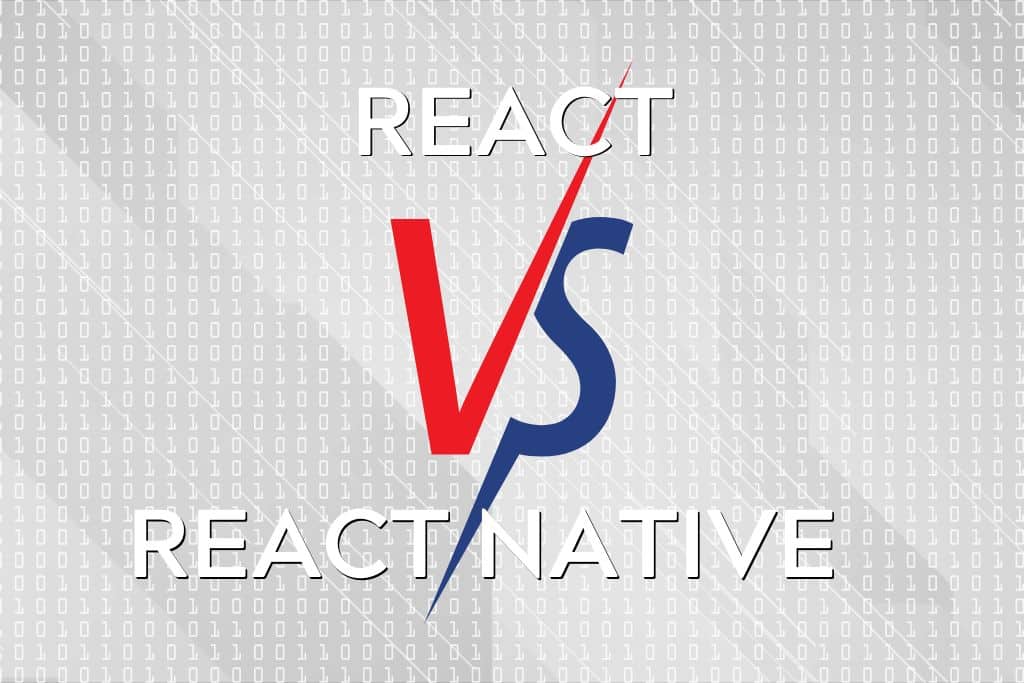From a functional standpoint, React and React Native do similar things. But they differ greatly in terms of architecture and scope. React (or ReactJS) is used to develop UIs for web pages or apps, while React Native functions as a way for developers to write mobile apps that work across multiple platforms, a.k.a hybrid apps.
React vs React Native, what is the difference? React is a library while React Native is an entire framework for developing mobile and web applications, with a slightly different syntax. For instance, React Native doesn’t use virtual DOM or HTML tags in its code (but it’s still based around ReactJS).
Today, I shall take a deeper look at what separates these two toolkits. As a developer, you might be interested in learning how easy or difficult it is to convert your frontend into React Native if you’ve built it with React. Both support reusable and modular code- but they work in very different ways.
Here’s a table comparing the major differences between React and React Native
| React | React Native | |
| What It Is | A component-based JavaScript library that is focused on UI design and visualization | A platform-agnostic framework based on React that allows developers to build native mobile applications |
| Made By | Jordan Walke at Facebook (now Meta) | The React team within Meta |
| Used For | Designing user interfaces for dynamic web apps | Building native cross-platform software using React and JavaScript |
| How It Works | Obfuscates the DOM behind a virtual copy that is created within memory and manipulated with a diff algorithm | Uses platform-specific APIs to wrap JavaScript code that can be run across multiple platforms with minimal changes |
| Advantages | Reusable and easy to maintain code that can be scaled up along with your project’s needs | Performance is close to native apps but you use simple JavaScript which makes development faster and more efficient across platforms |
| Animation | Uses HTML tags and CSS for styling | Has built-in animation library and uses CSS-in-JS for styling |
| External Library Support | Wide array of libraries and packages available that are constantly maintained and updated by the open-source community | Easy to find pre-built components and external libraries, but debugging for different platforms can be an issue |
| Used By | Pinterest, Netflix, Discord, Skype, etc. | Facebook, Instagram, Oculus, Tesla, Bloomberg, Walmart, MS Office, etc. |
History of React

These days, ReactJS is one of the most popular libraries for frontend web development- praised by industry professionals for being modular and intuitive. But how and why was it created? Back in 2011, the Facebook Ads web app was gaining a significant number of new users.
To contend with this giant sea of data, new developers were tasked with updating the code. Over time, the entire project turned into a confusing and unoptimized mess as it was scaled up to meet growing demand. To ease the process of code updates and management, Jordan Walke- one of the Facebook engineers, created FaxJS.
FaxJS itself was inspired by XHP, an extension to PHP that allowed for the creation of custom reusable HTML components. At the time, Facebook Lite was using this for its UI rendering layer. Eventually, FaxJS morphed into React which was made open source by Jordan Walke in 2013.
According to Jordan’s speech at the conference, one of his primary goals was to reduce the number of developer-facing mutations. Eventually, ReactJS got updates that featured ES6 class support and asynchronous “setState()” calls. Over time, React has evolved even further and supports several external packages that let you develop everything from interactive webpages to mobile games.
History of React Native
The origins of React Native lie in an internal hackathon hosted by Facebook in 2013. By 2015, Facebook made React Native open source, and the project eventually got uploaded to Github. Compared to coding hybrid apps with JavaScript and HTML, React Native lets you achieve significantly better performance through its unique “bridge”.
Performance is close to native apps for Android and iOS, but development pipelines are much more streamlined. You don’t have to be a veteran of Java or C. Instead, you can use your existing knowledge and experience with ReactJS to create excellent mobile apps with deep and interactive UIs.
With React Native, companies have a much easier time transforming their ideas into workable products that can be released to the store. Maintenance is also easier to do, thanks to React Native’s modular and reusable nature. With React Native, you should be able to write code once and deploy it onto multiple platforms (at least in theory).
Comparing Their Usage
I’ve mentioned this earlier about React, but it’s a JavaScript library designed for UI management within interactive webpages. What this means is your webpage dynamically updates its view, rendering elements in real-time based on user input and updates from the backend. DOM manipulation in React is much faster compared to jQuery because it uses a virtual DOM.
On the other hand, React Native is a whole framework for web and mobile app development that’s based on React. Its code syntax is different, with a lack of any HTML tags or CSS (however, it does use JSX and CSS-in-JS). The goal is to let developers create apps for Android and iOS that deliver near-native performance without being forced to use Objective C/ Java/ Kotlin.
Comparing Their Features

ReactJS has some pretty neat features that let you do more with less code. For starters, it utilizes a syntax similar to JavaScript which makes it really easy for developers to do all their scripting and styling with just one language. It also has one-way data binding, which is good for maintenance and updates to your code.
HTML can be used within ReactJS, and it has support for several external libraries via NPM. Changes to the view are updated in real-time which is excellent for streamlining development. Site indexing and loading are also faster with React, which is essential for drawing users to your site.
React Native handles things like animations differently, using APIs rather than CSS. It also comes with native modules for whatever platform you want. There are other cross-platform mobile app frameworks such as Cordova and PhoneGap.
But they use WebView for rendering, while React Native renders all of its components with Native APIs for a more accurate presentation. React Native lets you reuse the logic layer for both your iOS and Android apps. Plus adding React Native UI elements to existing app code shouldn’t be very hard.
Comparing How They Work
React (or ReactJS) shares many syntactical features with React Native. For starters, both use JSX- a JavaScript extension based on markup language. However, React Native uses native mobile UI components such as <View>, <Text>, <Image>, etc., while React relies on HTML and CSS tags such as <h1>, <p>, etc.
While it’s possible to develop mobile apps using ReactJS fundamentals with React Native, you will also have to learn developmental principles for the platform you’re working with (iOS, Android, etc.). The driving principle behind both React and React Native is “learn once, write anywhere”. With Native, you write your app and its runtime environment will create a “bridge” between your JS code and platform-specific elements.
ReactJS, on the other hand, is a tool for developing UIs on web pages/ web apps with JavaScript. It has components that exist independently of each other, with their own logic and controls built in. These components are designed to be reusable and work in conjunction with the virtual DOM system.
The virtual DOM creates a copy of the actual DOM in memory and implements changes to this copy based on user interactions. Then, it compares the new and old states of the copy to decide if it must change the actual DOM. Doing so results in a huge performance uplift over traditional DOM manipulation methods.
Comparing Their Advantages

The advantage of using React in comparison to something like jQuery, is that your web pages/ apps will load and perform faster thanks to virtual DOM. Code is also reusable and easy to scale up as your project grows bigger and gains users. React is also easy to learn for anyone familiar with JavaScript and HTML + CSS.
React Native is a mobile app development framework that works across platforms, much like Cordova or PhoneGap. Except, it performs better and is easier to develop with. The design of React Native allows for a more agile, hybrid development approach in which frontend web developers can work on mobile apps.
It automatically detects the file extension for your mobile app and loads corresponding native components. With React Native, you also get hot reloading which is useful to view changes immediately as you make them. Much like ReactJS, Native supports a wide range of 3rd party libraries and pre-built modules.
Conclusion
Obviously, ReactJS and React Native are not direct competitors and share many of the same principles- modularity, reusability, etc. I hope this article shed some light on the uses for either one, plus how they work. Depending on your line of work, you might find one more suitable than the other.
The nice thing about React Native is that it lets ReactJS web developers transition into making UI for mobile apps on Android and iOS. And the performance is close to what you get from native apps written in C or Java. Granted, you need to be good with your JavaScript and ReactJS fundamentals before you start making mobile apps on Native.

